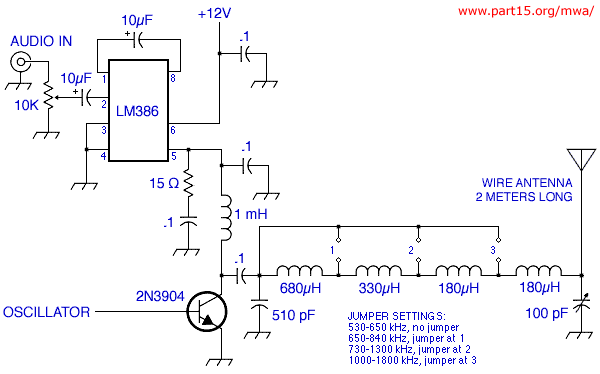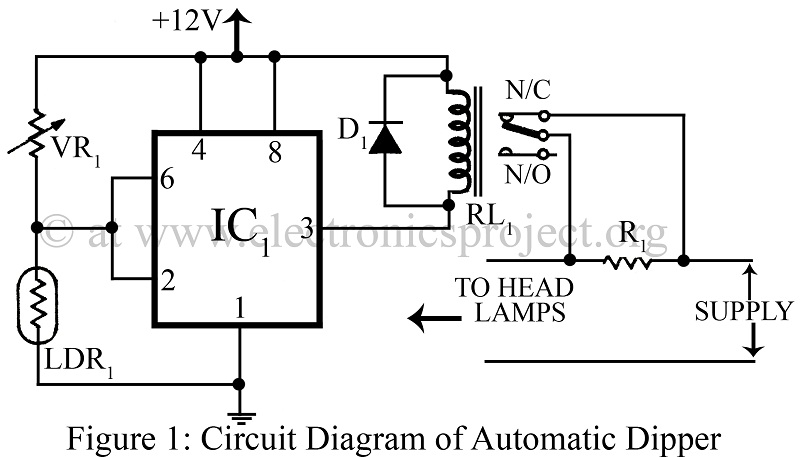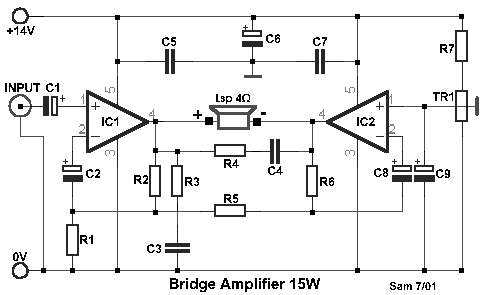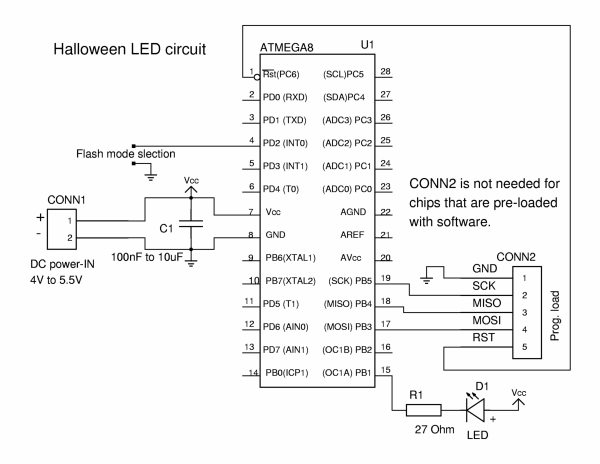
Little dipper

The circuit consists of two fundamental components: the oscillator and the detector. The oscillator employs a Field Effect Transistor (FET) in a Colpitts configuration. The energy circulating within the oscillator's tank is coupled through capacitor C4 to the detector circuit, where a small diode (D2) rectifies the signal, providing a direct current (DC) voltage to a Darlington pair (Q2, A3) that is regulated by a sensitivity control resistor (R3). Minor variations in the bias of the amplifier result in significant changes in the current flowing through the LED indicator in the DIP mode; conversely, in the PEAK mode, the current generates a corresponding voltage drop across resistor R5, reversing the action of the LED.
The circuit is designed to operate effectively across a frequency range from Low Frequency (LF) to Very High Frequency (VHF), provided that suitable components are selected.
The oscillator section utilizes a Colpitts configuration, which is characterized by its use of a capacitive voltage divider to create feedback for the oscillation process. In this setup, the FET serves as the active device, amplifying the oscillations generated by the tank circuit. The tank circuit typically consists of an inductor and two capacitors, which determine the oscillation frequency. The precise values of these components can be adjusted to achieve the desired frequency response.
Capacitor C4 plays a crucial role in coupling the output of the oscillator to the detector circuit. This coupling allows for the transfer of the oscillation energy without significantly loading the oscillator, ensuring stable operation. The detector circuit, featuring diode D2, functions as a rectifier, converting the AC signal produced by the oscillator into a DC voltage. This rectified voltage is essential for driving the subsequent amplification stage.
The Darlington pair configuration, comprising transistors Q2 and A3, is utilized to provide high current gain, which is beneficial for driving the LED indicator. The sensitivity control resistor (R3) allows for adjustment of the amplifier's bias point, enabling fine-tuning of the circuit's response to incoming signals. This feature is particularly useful in applications where signal strength may vary.
The LED indicator serves as a visual output, providing feedback on the circuit's operation. In DIP mode, the LED's brightness corresponds directly to the current flowing through it, which varies with the input signal's amplitude. In contrast, the PEAK mode alters the response by introducing a voltage drop across resistor R5, which inversely affects the LED's operation, providing a different visual indication of the signal's characteristics.
Overall, this circuit design is versatile and can be adapted for various applications within the LF to VHF range by selecting appropriate components that match the desired operational frequency and performance specifications.The circuit consists of two basic circuits, the oscillator and the detector. The oscillator uses an FET in a Colpitts configuration. The energy circulating in the oscillator tank is coupled through C4 to the detector circuit, where a small diode (D2) rectifies it, feeding a dc voltage to the Darlington pair (Q2, A3) controlled by the sensitivity control (R3). Any small variations in the bias of the amplifier will cause large variations of current through the LED indicator in the DIP mode; however, ih the PEAK mode the current produces a corresponding voltage drop through R5 and the action of the LED is reversed.
The circuit shown will work practically on any frequency from LF to VHF if the appropriate components are used.
The circuit is designed to operate effectively across a frequency range from Low Frequency (LF) to Very High Frequency (VHF), provided that suitable components are selected.
The oscillator section utilizes a Colpitts configuration, which is characterized by its use of a capacitive voltage divider to create feedback for the oscillation process. In this setup, the FET serves as the active device, amplifying the oscillations generated by the tank circuit. The tank circuit typically consists of an inductor and two capacitors, which determine the oscillation frequency. The precise values of these components can be adjusted to achieve the desired frequency response.
Capacitor C4 plays a crucial role in coupling the output of the oscillator to the detector circuit. This coupling allows for the transfer of the oscillation energy without significantly loading the oscillator, ensuring stable operation. The detector circuit, featuring diode D2, functions as a rectifier, converting the AC signal produced by the oscillator into a DC voltage. This rectified voltage is essential for driving the subsequent amplification stage.
The Darlington pair configuration, comprising transistors Q2 and A3, is utilized to provide high current gain, which is beneficial for driving the LED indicator. The sensitivity control resistor (R3) allows for adjustment of the amplifier's bias point, enabling fine-tuning of the circuit's response to incoming signals. This feature is particularly useful in applications where signal strength may vary.
The LED indicator serves as a visual output, providing feedback on the circuit's operation. In DIP mode, the LED's brightness corresponds directly to the current flowing through it, which varies with the input signal's amplitude. In contrast, the PEAK mode alters the response by introducing a voltage drop across resistor R5, which inversely affects the LED's operation, providing a different visual indication of the signal's characteristics.
Overall, this circuit design is versatile and can be adapted for various applications within the LF to VHF range by selecting appropriate components that match the desired operational frequency and performance specifications.The circuit consists of two basic circuits, the oscillator and the detector. The oscillator uses an FET in a Colpitts configuration. The energy circulating in the oscillator tank is coupled through C4 to the detector circuit, where a small diode (D2) rectifies it, feeding a dc voltage to the Darlington pair (Q2, A3) controlled by the sensitivity control (R3). Any small variations in the bias of the amplifier will cause large variations of current through the LED indicator in the DIP mode; however, ih the PEAK mode the current produces a corresponding voltage drop through R5 and the action of the LED is reversed.
The circuit shown will work practically on any frequency from LF to VHF if the appropriate components are used.





